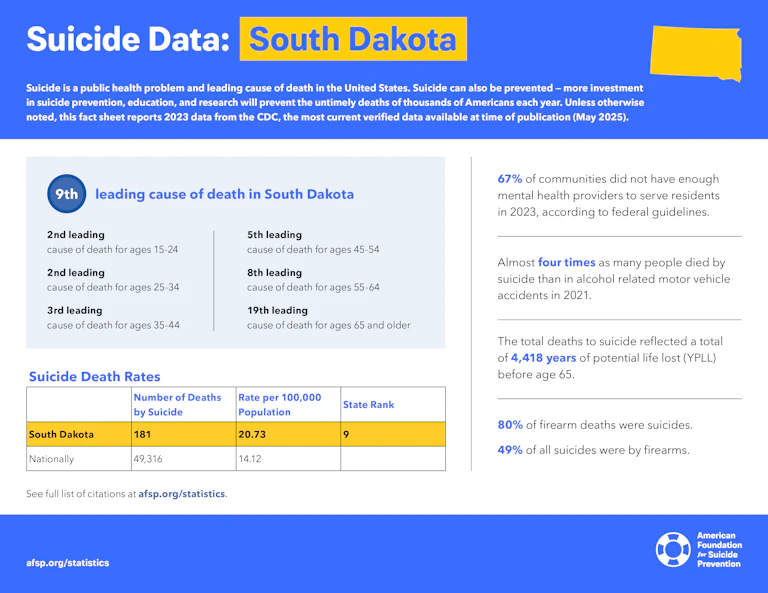South Dakota

South Dakota suicide prevention plans and initiatives
South Dakota’s suicide prevention activities are led by South Dakota Suicide Prevention, a nonprofit organization affiliated with the South Dakota Department of Social Services (DSS) that provides regional suicide data, best practice recommendations, community toolkits, information on statewide trainings, and guides on how to help individuals at-risk for suicide. In 2019 the Governor tasked state agencies with creating a state suicide prevention plan, prompting the South Dakota Departments of Health, Social Services, Education, Tribal Relations, and Agriculture, as well as the Great Plains Tribal Chairmen’s Health Board to form a work group and develop a framework that included guiding principles, goals, objectives, and strategies based on a review of national strategies and the state’s previous suicide prevention efforts.
In the fall of 2019, stakeholders and the public provided input on the draft, which was then incorporated produce the final document and release the South Dakota Suicide Prevention State Plan 2020-2025. The workgroup has also since published regular reports, including the South Dakota Suicide Prevention Plan 2020 Priority Strategies, 2020 Priority Strategies Outcomes Report, 2021 Priority Strategies, 2022 Priority Strategies and the most recent 2023 Priority Strategies
South Dakota laws
Key:
- Required by law
- Encouraged by law
- No law in place
Crisis lines and 988 implementation
- Addresses 988 infrastructure and provides for telecom user fee
- Addresses 988 infrastructure but does not include telecom user fee
- 988 law limited to creating an exploratory commission, advisory committee, or task force
Mental health parity
- Public health plans (e.g., Medicaid) regularly submit parity compliance analyses to state regulators
- Private health plans (individual and group) regularly submit parity compliance analyses to state regulators
K – 12 school suicide prevention
- Inclusion of the 988 Suicide & Crisis Lifeline and/or other crisis line(s) on student ID cards
- Student allowances for excused mental health absences
- School personnel must report student suicide risk to a parent and/or guardian
- Suicide prevention and/or mental health training for certain school personnel, annual
- Suicide prevention and/or mental health training for certain school personnel, not annual
- Suicide prevention, intervention, and postvention policies/programming
- Student education on suicide prevention
Health professional training in suicide assessment, treatment and management
- Mental health professionals receive regular training
- Mental health professionals receive one time training
- Medical/surgical professionals receive regular training
- Medical/surgical professionals receive one time training
Conversion therapy bans
- Prohibits licensed/board certified mental health providers from engaging in conversion therapy with minors under 18 years of age
- Prohibits licensed/board certified mental health providers from engaging in conversion therapy with vulnerable adults
- Prohibits use of state funds for any purpose related to conversion therapy (e.g., conducting, making a referral for, or extending health benefits coverage for)
University and college campus suicide prevention
- Inclusion of the 988 Suicide & Crisis Lifeline and/or other crisis line(s) on student ID cards
- Students receive information on available mental health and/or suicide prevention services and/or resources
- Adoption of suicide prevention/awareness policy or program
Firearms
- Process for extreme risk protection orders (ERPOs)
- State voluntary do not sell list